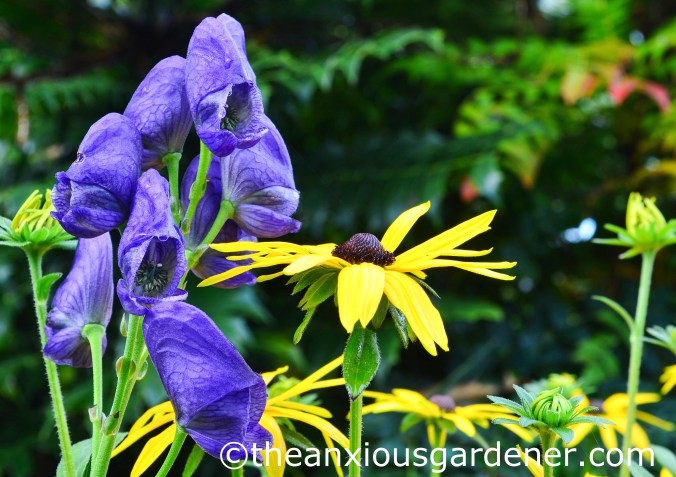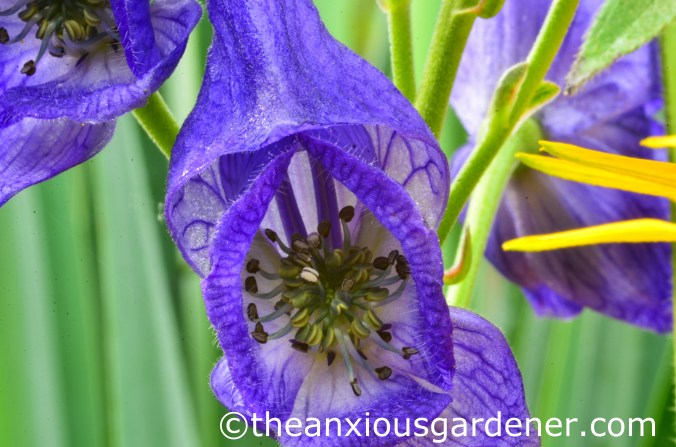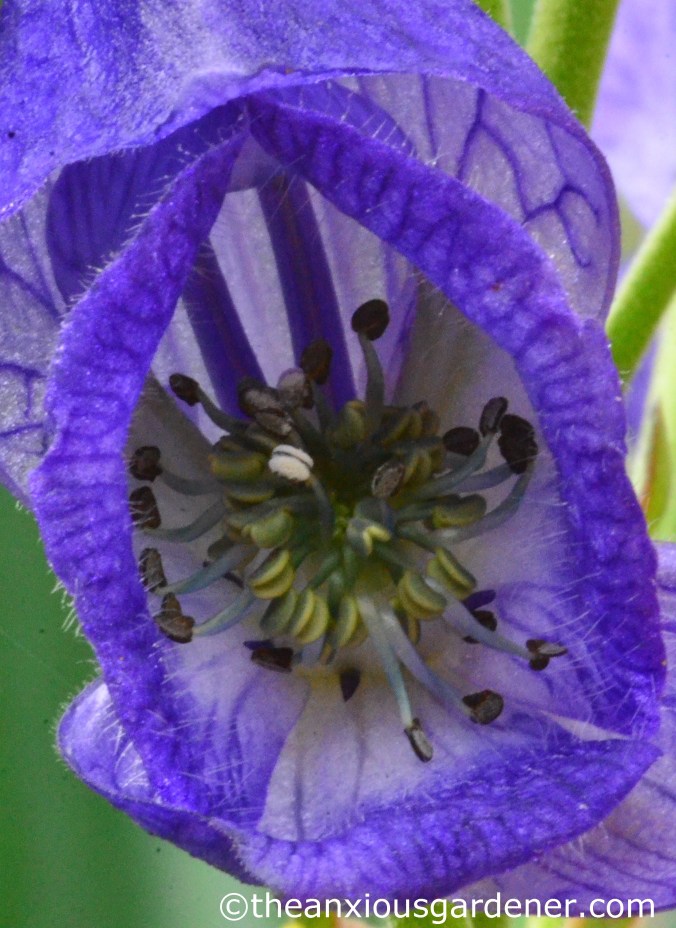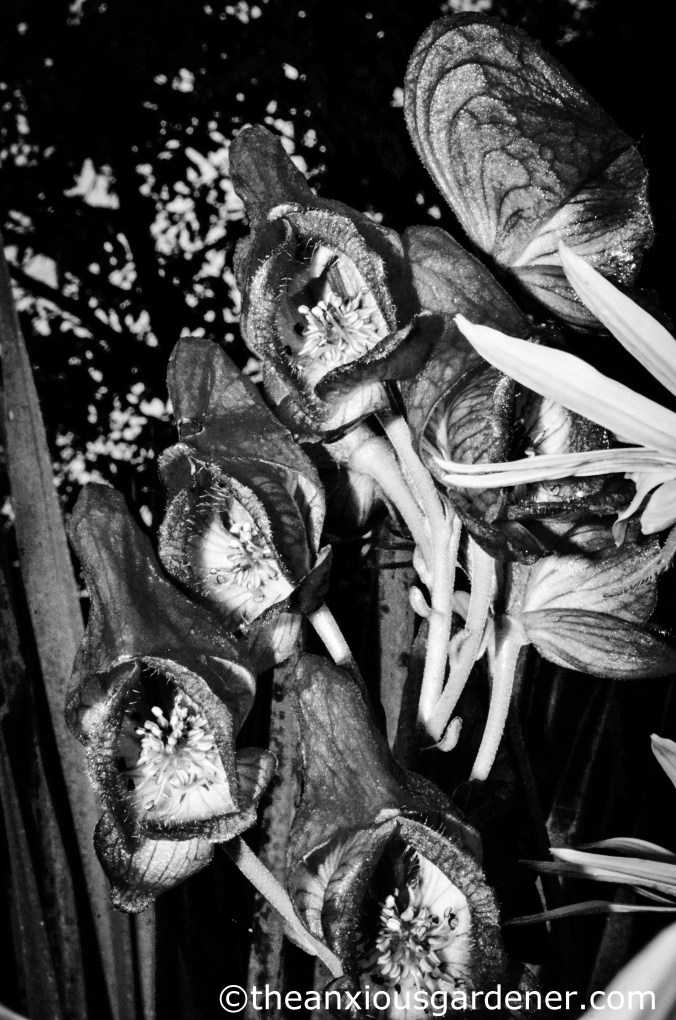I started growing aconitum after seeing it in a neighbour’s border. I was nosing over the garden wall (a favourite past-time) and asked Mary about her tall plant with the striking flowers. She told me its common name, monkshood, and that she grew it as a substitute for delphiniums – which, after unrelenting slug slaughter, she had abandoned in disgust.
Aconitum napellus is similar in height to delphinium but flowers later (mine don’t get going until September/October). It is happy in dry shade and, as Mary said, untroubled by molluscs. I like the slightly sinister, dark-blue flowers. They remind me of a boyhood dream: a cowled, faceless monk flitting from one dark tree to the next, but coming ever closer. (Why I should want reminding of that particular nightmare is any psychoanalyst’s guess).
I knew monkshood was poisonous when I introduced it to the Priory but I wasn’t particularly concerned: foxglove is poisonous, rhubarb leaves are poisonous, so too is yew. Many of our common garden plants are potentially deadly but, as I only graze on plants I’m triply certain are safe, aconitum’s toxicity was only of mild interest.
Right up to the moment I read of Nathan Greenway, the unfortunate 33-year-old gardener who died, supposedly, just from touching the plant. Now that did grab my attention. For several winters, I have grasped aconitum when cutting back in winter – with never a thought for gloves. Could this plant really kill by contact alone? Could it be poisonous enough to cause multiple organ failure and death ten days later? Well, that’s how the media reported the story last November and that is when I first developed Aconitum Anxiety.
Originally, I planned to write about a plant which I rather like and add two simple warnings: avoid touching it and avoid touching it – even casually or inadvertently. But as that struck me as a ludicrous caveat for a border plant, I was even going to recommend tossing it on the bonfire (prudently avoiding the smoke). But then I thought, hang on a moment: I’ve often touched the plant to no harm and actually, I hadn’t ever seriously considered ripping up all the monkshood at the Priory even after reading about its deadly effect on another gardener. I decided to look again at the case and check whether there had been any developments since last year.
After a quick Google search, I found John Robertson’s website, The Poison Garden and read two blog posts about Nathan Greenway: one written in November 2014 at the time of the pre-inquest hearing and a follow-up in June 2015 after the full inquest. And on the strength of these articles, I rewrote my initial draft.
At this stage, I should underline the blatantly obvious – I am no expert on plant toxicology. John however is and after reading his posts it was clear that aconite poisoning wasn’t the cause of death in this instance. Firstly, neither aconite nor aconitine (the two relevant poisons) cause multiple organ failure; secondly, death, when it occurs, is very rapid; and thirdly, fatalities from the plant have only been recorded by ingestion. Cases of death by contact with aconitum are unknown which, considering how common it is, seems particularly pertinent. The coroner at the inquest, explicitly stated that Nathan had not handled the plant – only that he might have brushed against it. And because that alone wasn’t consistent with aconite toxicity, he recorded an open verdict. To quote from John’s blogpost – “The cause of death is multiple organ failure of unknown cause.” If you’d like to read more detail about this tragic case – and the initial alarmist reporting by some of our media (specifically The Daily Mail) – I recommend the above two links. For further information about how poisonous aconitum is (and isn’t) here’s the link to John’s fascinating aconitum page. (Sadly, since writing this blogpost, John’s website has disappeared. David, 2023)
If you grow aconitum, and heard the news reports last year, you too probably suffered from Aconitum Anxiety. If so, I hope I’ve reassured you or rather, John Robertson has. John’s website also taught me to take one precaution. As my hands are usually sliced or stabbed bloody by thorns, I no longer grab monkshood without first pulling on a pair of gloves. I wouldn’t want the plant or its sap coming in contact with even a minor wound. On balance though, I would suggest that you continue to grow monkshood if it pleases you. Admire the late summer blooms, use it in shade where other plants might struggle, wear gloves when handling (as you would to guard against euphorbia sap) but – most importantly of all – for goodness sake don’t eat it. In this instance, slugs and snails know best.
As far as I know, there is still no satisfactory explanation for the exact cause of Nathan’s death. I can’t imagine how difficult this past year must have been for the Greenway family – to whom I offer my sincerest condolences.




Hi Tiffany, yes that is a shame. I didn’t know that The Poison Garden was no more. I wish I could provide some foolproof advice but never having grown Aconitum seed from I can’t. Sorry. You need to hunt down a friend or neighbour with some spare plants! Best, Dave
LikeLike
No worries, something will come up. Great site, thanks for sharing you life with us.
LikeLiked by 1 person
You’re very welcome 🙂
LikeLike
A shame that John Robertson’s website is no longer up and running. I am an amateur phytotoxicologist and so far have had no luck growing Monkshood from seed. I’m sure it is even more stunning in person, but love your pictures. Glad for your wisdom, especially about how much shade it can withstand. I’ve got the perfect place for it beneath a cedar tree if I could just get it going.
LikeLiked by 1 person
I got a bouquet from the farmer’s market and seeing that one beautiful flower was significantly longer-lasting than the others, I set out to identify it. I handled it multiple times (in arranging the bouquet and later when rearranging it as I took out the wilted flowers) with no ill effects. So to find out that it is considered extremely poisonous was very surprising to me. Maybe some people are more sensitive than others (though I do have sensitive skin, so I would have thought I’d be one of the former in this case) or maybe it, like daphne and lilies as noted in previous comments, is only *really* poisonous when ingested. Regardless, from now on I will take more care when handling it!
LikeLiked by 1 person
Hi and yes, that is my understanding too. The plant is only truly dangerous when ingested and handled with a cut or cuts to the hand or fingers. Nevertheless, I shall be planting aconitum in my new garden (I have a perfect shady spot for it) but will always use gloves when handling. Just in case! Thanks for commenting, D
LikeLike
Pingback: A chance encounter with monkshood, our most poisonous plant | Philip Strange Science and Nature Writing
Thank you for this help me a lot I wonder if any one has grow this plant in a big tub would love hear if and one as .
LikeLike
Hi John, I haven’t but maybe somebody else might chip in. I can’t see why it wouldn’t work in a planter though – they’re pretty resilient plants. D
LikeLike
Dang. I just found your blog. Bad timing. Sounds like you’re winding down. Just bought a monkshood and saw the story about the gardener who died. Then I read your blog. I think I’ll plant it after all.
LikeLike
Good choice, I think, Patricia – though this year many of mine have shrivelled for lack of water. D
LikeLike
Pingback: Mid October Flowers | New Hampshire Garden Solutions
One of the biggest patches of aconite I’ve seen here is in a children’s park. Obviously the planter had no idea what he / she was planting but there hasn’t been any trouble that I’ve heard of.
Still, if I knew how to get ahold of the person in charge I’d alert them to the possible dangers. They don’t come much more poisonous than aconite.
LikeLike
I agree Allen that does seem particularly stupid in a children’s park. Under-planted with deadly nightshade perhaps? D
LikeLiked by 1 person
Well. I love desert gardening, but sometimes the limitations do get discouraging. I mean, if we want to endanger ourselves (or others) we have to do it in vulgar, obvious ways, like with yucca leaves or cactus spines–no subtly sinister flowers for us. Tsk. Interesting post, Dave, and beautiful close-ups!
LikeLiked by 1 person
A little odd isn’t it that I too spar with cactus thorns and yucca leaves. I used a pair of gloves recently to re-pot a cactus. Elemental mistake. Normally I use folded newspaper to grab hold and now I remember why. The spines effortlessly pierced the gloves and in such numbers I had to throw them away. Tsk indeed. D
LikeLiked by 1 person
Yes! I did the same thing with a cactus and a brand new pair of gloves! NO idea why it seemed like a reasonable thing to do.
LikeLike
Oh good! I mean, oh no! But oh good – that I’m not the only one to follow the path of reasonableness only for it to go so wrong. 😦 D
LikeLiked by 1 person
I grow poppies and I understand they are poisonous, too. That said, there are poisons and there are poisons.
The aconitums would be brilliant in my front garden but I think I will err on the side of cautions, all things being equal 😉
LikeLike
Your choice, Helen and that is the beauty of our own gardens. We grow what we want and what we feel comfortable with. Great isn’t it?! Dave
LikeLiked by 1 person
Such beautiful flowers but I’ve been scared off planting them. They have a very bad name and make me think of what it would be like if you poisoned your grandchildren or the grandchildren of somebody else, yet I’ve never had any children wandering around the garden eating the flowers. Toxic paranoia? Amelia
LikeLike
I’m going to write a follow up to this post I think, Amelia – it raises as many questions as it answers. And no. Kids are far more likely to eat something like laburnum pods than flowers (and do) because they look edible (sort of). I don’t think you are being paranoid but I still think it’s a beautiful plant. Dave
LikeLiked by 1 person
This is such an interesting post, not just as its about a fascinatingly deadly if beautiful plant but about toxic nature of so many garden worthy plants. I really enjoyed reading it and the comments, the poison garden website is great, it’s a bit like a horticultural chamber of horrors.
LikeLike
It is a little like a chamber of horrors, isn’t it? Makes me wonder how we ever gird our loins sufficiently to even venture out into our gardens let alone start grappling with them. Dave
LikeLike
Here is a bit more background: http://naturespoisons.com/2014/02/20/aconitine-queen-of-poisons-monkshood/
LikeLike
Thanks for that Philip. When I started researching this piece, I found an awful lot of information but was particularly drawn to John’s site above (and I see he has commented on the the naturespoisons post). Dave
LikeLike
I am surprised the government has not banned it entirely.
LikeLike
I can’t say I’m particularly surprised Robert. It would be a long list of garden plants if any government were to proscribe plants because they were poisonous! Dave
LikeLike
If you had children regularly visiting the garden you might have to think again about removing the beautiful Aconitums. Many plants are poisonous but apart from fungi I don’t think any are quite as poisonous as Aconitum.
LikeLike
Probably true, Christina though my own son used to come to the Priory often and, to be honest, it never occurred to me that he would ever eat any plants in the borders. Having said that, if he was still young (ie not a 6ft 2 rugby playing 15 year old) I might hesitate to plant aconitum in my own garden. D
LikeLiked by 1 person
Perhaps poor Nathan ate wild mushrooms? It was autumn after all.
I get a rash from handling it, which I discovered while working as a florist. It was off my list from then on!
LikeLike
Hi Eliza, I imagine that eating mushrooms would have been known by the coroner but I really don’t know. I specifically read about aconitum affecting florists – can understand you giving it a wide berth afterwards. Dave
LikeLike
We used to have it in an old garden where we rented. I remember seeing it in the Alnwick poison garden. You could only enter on accompanied visits.
LikeLike
Yes! We went around the Alnwick poison garden in August. I have to admit to being a tad underwhelmed – probably because much of what was there I already grow! (Except for the cannabis – obvs). Dave
LikeLike
Thanks for clarifying the case about Aconite, David. Following the media reporting (Some in the gardening press) you would be forgiven for removing the plant from your garden. I have to confess to some times feeling a bit of a wimp for always wearing gloves due to previously requiring an injection for tetanus after a cut on rusty metal while gardening.
LikeLike
I probably err the other way, Brian and don’t wear gloves enough. Perfectly understand why you’re extra careful now – I should probably follow suit. Dave
LikeLike
Daphnes are also poisonous. And did you realise the bulbs of daffodils are poisonous as well? It’s amazing any gardeners are still alive!
LikeLike
That’s true, AP – which is why personally I wasn’t too concerned about aconitum being poisonous. As you point out, eating a range of garden plants to test how dangerous they might be would be a short-ish experiment. D
LikeLike
I love aconitums, the flowers are so architectural, and come in glorious blues. I am relieve that they aren’t as horrendously toxic as the Daily Mail suggested, though so far I’m not growing any here. I wanted to add it to my front garden but I’m worried the cats that visit will munch it since they seem to like at least sniffing all my plants if not actually nibbling. What do you think, are they moggie friendly? I hope so ‘cos you have reminded me how wonderful they are…
LikeLike
Can’t help you with that, Janet I’m afraid. I know the plant tastes bitter so isn’t palatable and there was no record of a pet death I found other, than as I told Helen below, a dog that buried a bone amongst the plants and ate a bit of root – which is especially toxic. So I would say it isn’t likely to be dangerous to cats (but I’m not putting my hand on heart here)! It is a good looking plant though, I agree. Dave
LikeLike
I have to admit when I heard the story I thought it was the media being alarmist. I haven’t grown aconitum as I know it’s poisonous and my cat munches in everything. Saying that I learnt today that Colchicums are also posionous, although there have only been two deaths this century, both from eating the leaves. I think caution is sensible and I wonder if animals can tell that they need to avoid eating certain things.
LikeLike
I guess you don’t grow lilies either then, Helen? I know that the pollen is poisonous to cats. Incidentally, one of the deaths by aconitum poisoning that I read about on The Poison Garden was a dog which had buried a bone at the base of the plant and subsequently died. I don’t suppose it chose to eat some of the roots but did so by accident.
LikeLike